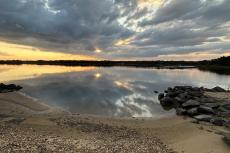Concerned Citizens of Montauk's weekly roundup of bacteria levels in local waters identified five test areas in Montauk and East Hampton that had elevated levels of the bacteria enterococcus.
C.C.O.M., which partners with the Surfrider Foundation's Eastern Long Island Chapter to create and disseminate the weekly reports, said entero levels of above 104 MPN/ml (most probable number per millimeter) are harmful to humans -- and three of the five high-bacteria samples eclipsed that benchmark, including at Lake Montauk's East Creek, which came in at 1,904 MPM/ml, up from 1,354 in last week's report. The area of Accabonac Harbor east of the culvert registered a bacteria level of 281, while the culvert at Northwest Creek in East Hampton came in at 148 (down from 1,166 last week).
Back in Montauk, C.C.O.M.'s water sample taken at Tuthill Pond had a bacteria count of 98 (down from 345 last week) and a sample taken near Tuthill Road on Fort Pond Bay rounded out the five waterways with high entero concentrations, at 86. The most elevated bacteria count in Amagansett was registered at the creek at Fresh Pond: 41 MPN/ml, which is considered a medium bacteria load.
The organization did not test for bacteria in Montauk Harbor or the causeway south area of Lake Montauk (near Star Island) but also listed them as areas with high bacteria levels.
Concerning that outsized bacterial load at East Creek, Jaime LeDuc, program manager at C.C.O.M, said in an email that her organization and East Hampton Town are "in the process of investigating the source of the high bacteria in East Creek to identify the most appropriate remediation efforts. It could be human or animal, but surprisingly, the East Creek sub-watershed at the southeastern tip of Lake Montauk is not characterized by intensive development. More research is needed."
Bacteria levels can spike after heavy rains, king tides, and/or warming water temperatures. C.C.O.M. has ongoing remediation projects or intensive testing underway at 15 of the 33 waterways listed in its report.
The bacteria live in the intestinal tracts of humans and other warm-blooded animals and can be tracked back to wastewater-treatment plant effluent, leaking septic systems, stormwater runoff, and sewage dumped from boats and other sources. The bacteria "are indicators of the presence of fecal material in the water and, therefore, of the possible presence of disease-causing bacteria, viruses and protozoa," warns the federal Environmental Protection Agency on its online portal. They can "sicken swimmers and others who use rivers or streams for recreation or eat raw shellfish or fish."
C.C.O.M. also conducts weekly tests for toxic blue-green algal, or cyanobacteria, blooms, but didn't find any in sample sites located at the Fort Pond boat ramp and near Industrial Road in Montauk.



